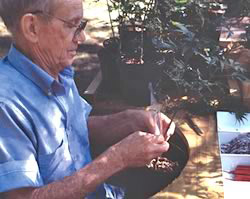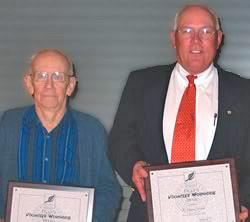Johnny Appleseed of Japanese Maples Scatters His Magic at Auburn
By: Ken Tilt

Harold Johnston
Harold Johnston is an unlikely candidate to become the mentor to AU professors, students and researchers as well as to Master Gardeners and industry professionals throughout the Southeast, but many people are thankful to Harold for sharing his knowledge and enthusiasm for Japanese maples and life.
My interest in Japanese maples led me to Harold around 1992. As often happens among passionate plant people, I found Harold through word of mouth. I was talking about plants with someone and mentioned Japanese maples, and their response, which I have mimicked to others many times since, was “Do you know Harold Johnston in Elmore County?”
I got a phone number and called to ask if I could drop by for a maple visit. “Come on, I’ll be here,” was his response. I rambled the back roads between Auburn and Montgomery near Tallassee and rounded a bend in the road off County Road 8 where I spotted his house across from a country filling station. I pulled into the driveway of an unassuming small house on about an acre lot that was graced with eight or ten Japanese maples. It did not have the appearance of an avid collector.
Harold, a retired mechanic who weighs (in his own words) about 90 pounds after a good rain, met me on his front porch. This began what was to become a regular ritual of sitting on the porch swing and discussing the latest cultivars or the anticipation of what new scion wood was arriving soon. We then ambled around to the back of the house to see what unusual branch sports he had found and tagged or what amazing colors or twists he had found among his seedlings. We continued to tiptoe our way through the pots and admire what then was well over 400 cultivars of Japanese maples.
There may have been only eight or ten maples in the front yard but you could not squeeze a quart pot among the thousands of containers in the back. He had labels on the maples he was selling for the benefit of his customers, but he could spot and name all of the 400 cultivars. They were mostly in one- to five-gallon containers because there was not room for a major arboretum display. This is where the Auburn University relationship began.
Harold took me, an Auburn University professor, under his wing and began to teach me the art of grafting and sharing his treasures with the university. I knew the science of grafting, but I was a few hundred thousand grafts behind my “Master Grafter” mentor. I would follow behind him as we meandered through his collection bending the twigs to determine their readiness for grafting. If they were ready, he would pull out his razor-sharp knife and, using his thumb to press the cutting to the knife blade, harvest 20 or so prime scions by deftly bending and cutting at the same time. He would then stick them in his blue jean pocket and move to the next cultivar and repeat the same procedure. However, he would stick the scions in the same pocket. I asked him if he needed to label them and put a rubber band around the bundles. He laughed and said he knew what they were, and he did.
We spent some scattered days beneath the shade of a large pecan tree in Harold’s front yard practicing the craft, discussing Japanese maple future needs—such as an orange cultivar to match Auburn University’s colors—as well as sharing some political views and other topics of nothingness. I later published his teachings for the nursery industry to use in the International Plant Propagators Proceedings. Though he broke many of the textbook rules of collecting and preparing his scion wood, I still marvel at his efficient wielding of his knife as he prepares delicate scions of Beni Komo No Su (a fine, hair-thin branched cultivar) as easily as he prepares pencil-sized scions of Bloodgood. I always went home to Auburn feeling better than when I arrived with my grafts and a few of Harold’s take-home maples (gifts) to plant at Auburn for the students and industry professionals to see as they matured.
A close relationship evolved and Harold quietly consented to my urgings to help teach students, Master Gardeners and friends to experience and develop a life-long skill and hobby in the Japanese maple world. He also came at my invitation to teach grafting seminars at our Nursery Trade Show Seminars and area nursery meetings. Most nurseries with Japanese maples around the country, and other countries, know Harold well. He receives frequent shipments of new scion wood with an invoice stamped “NO CHARGE.” He reciprocates by sending and sharing his new “finds.”
Over the years I know he has given away many more plants than he has sold from his nursery business, Johnny’s Pleasure Plants. The name of his nursery defines his passion for plants. His wife, Johnny, lovingly fusses at him often because he does too much, and he does, but confides privately that he would probably die if he did not have his maples to keep him active. It is embarrassing to have an older and a 160-pound-lighter man say, “let me get those pots for you and load your truck.”
I often refer to him as the Johnny Appleseed of Japanese maples. He shared one of his treasured prepatented Beni Shien maples for us to evaluate at Auburn. It is not a maple that has reached the mass market yet, but it is one of the most distinct, unusual and special plants among our collection. It is a lot like Harold: one of a kind.

Workhorses–Harold Johnston, left, of Elmore County and K. Galen Grace of Auburn were recipients of the College of Agriculture’s 2005 Workhorse Award, an honor that is given annually to college alumni or friends who have demonstrated outstanding service to and support for the college. Johnston, a retired mechanic, is a quiet Japanese maple guru who willingly shares his knowledge and expertise. (See story above.) Grace regularly helps establish and fund new scholarships, recruits new students into the department and the college and helps students find jobs.
